Physical Address
304 North Cardinal St.
Dorchester Center, MA 02124
Physical Address
304 North Cardinal St.
Dorchester Center, MA 02124
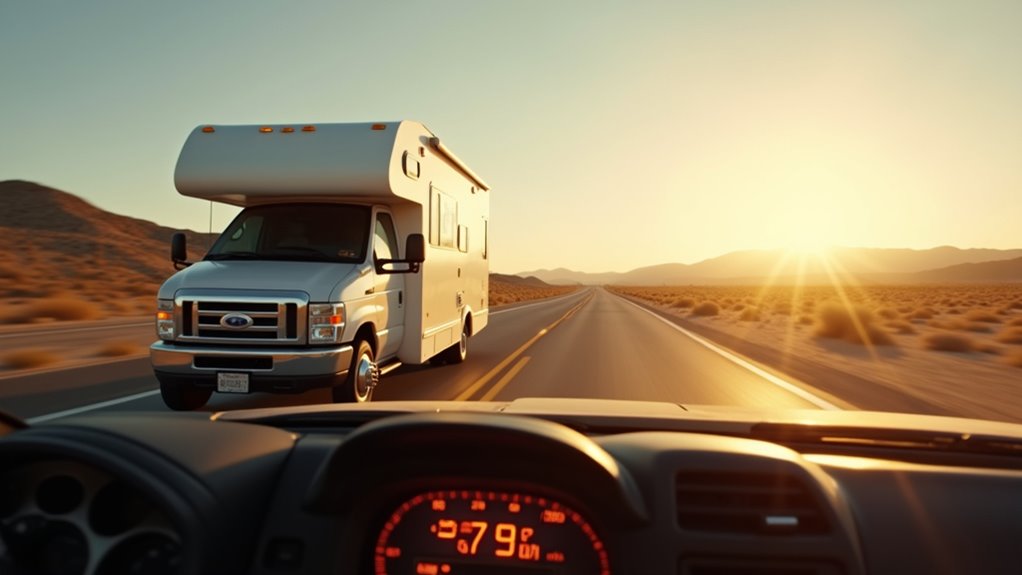
In the world of RV travel, your fuel range varies dramatically - discover the key factors that determine your journey's reach.
If you’re planning your first RV adventure, you’ll quickly discover that fuel range is a vital factor in your journey. Your RV’s traveling distance on a single tank isn’t as straightforward as with a regular car. It depends heavily on whether you’ve chosen a Class A motorhome, Class B van, or Class C RV – each with its own fuel efficiency and tank capacity. Understanding these differences can save you from unexpected pit stops and help you plan smarter routes.
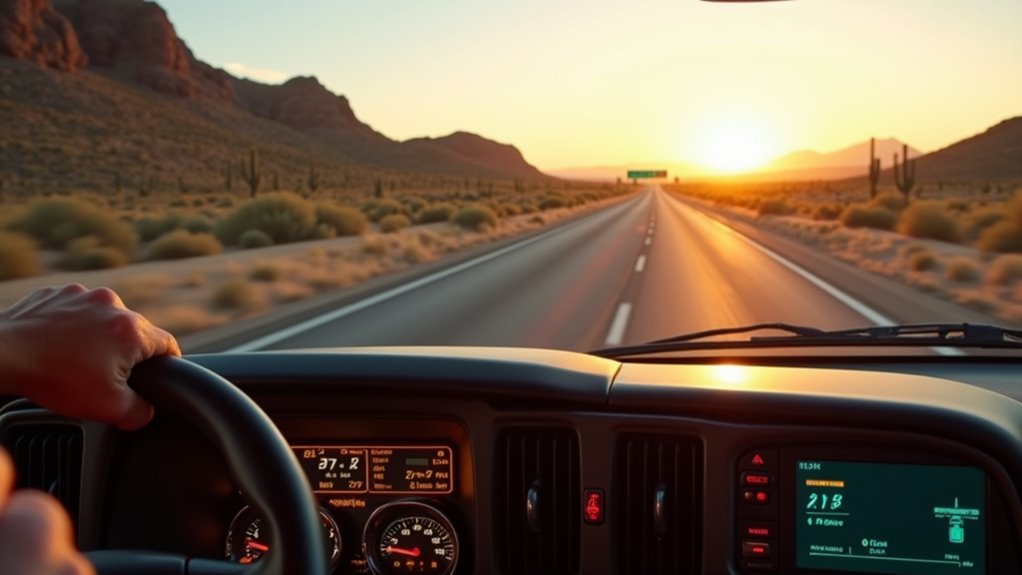
Fuel tank capacity is one of the most vital specifications to understand before purchasing or operating an RV.
Understanding your RV’s fuel tank capacity is crucial for smart buying decisions and successful road trip planning.
You’ll find significant variations across different RV classes, with Class A models offering the largest tanks, typically ranging from 80 to 150 gallons. Class B RVs have much smaller tanks, averaging around 24 gallons, while Class C models fall in between with 25 to 55 gallons.
If you’re considering a diesel RV, especially a Class A “pusher,” you’ll often get a larger fuel capacity than gasoline models. Luxury manufacturers like Tiffin offer tanks up to 150 gallons. These larger tanks can provide a driving range of up to 1,000 miles before needing to refuel.
The exact size can vary between manufacturers and specific models, so you’ll want to check the owner’s manual or product specifications for precise measurements. This information is essential for planning your trips and calculating how often you’ll need to refuel.
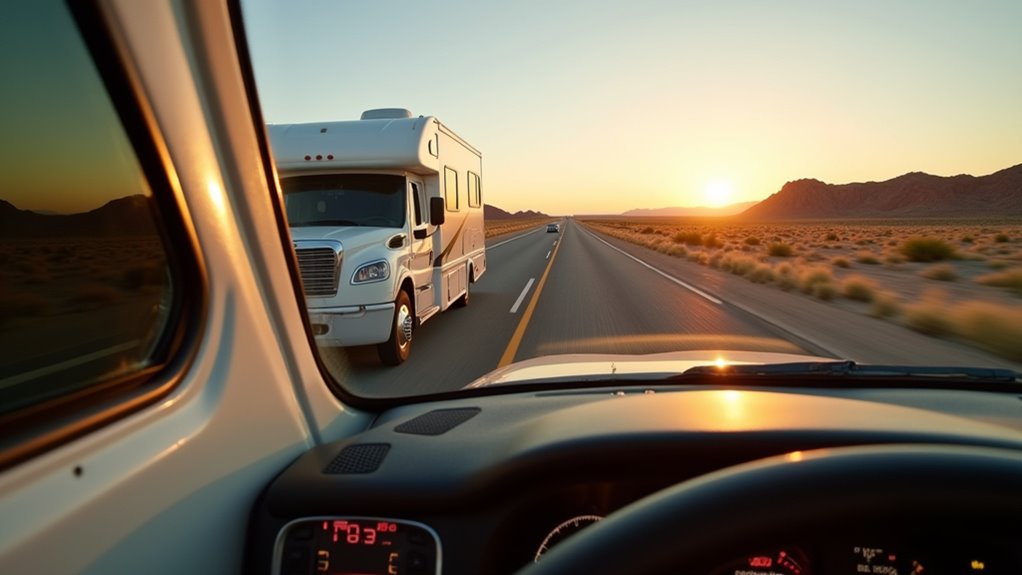
Now that you know your RV’s tank capacity, you’ll want to understand how far you can actually travel before needing to refuel. Your range will vary greatly depending on which class of RV you drive.
In a Class A motorhome, you can expect to travel 300-500 miles on a 50-gallon tank, averaging 6-10 mpg.
Class B vans offer the best efficiency at 13-22 mpg, covering 312-528 miles on a typical 24-gallon tank. The Winnebago Travato 59G leads the pack with its highest efficiency rating of 22 mpg.
Class C RVs strike a middle ground, traveling 280-720 miles on a 40-gallon tank at 7-18 mpg.
Remember that your actual range depends on several factors. Heavy loads, mountain driving, and aggressive acceleration will reduce these estimates.
Diesel engines typically offer better range than gas engines across all classes.
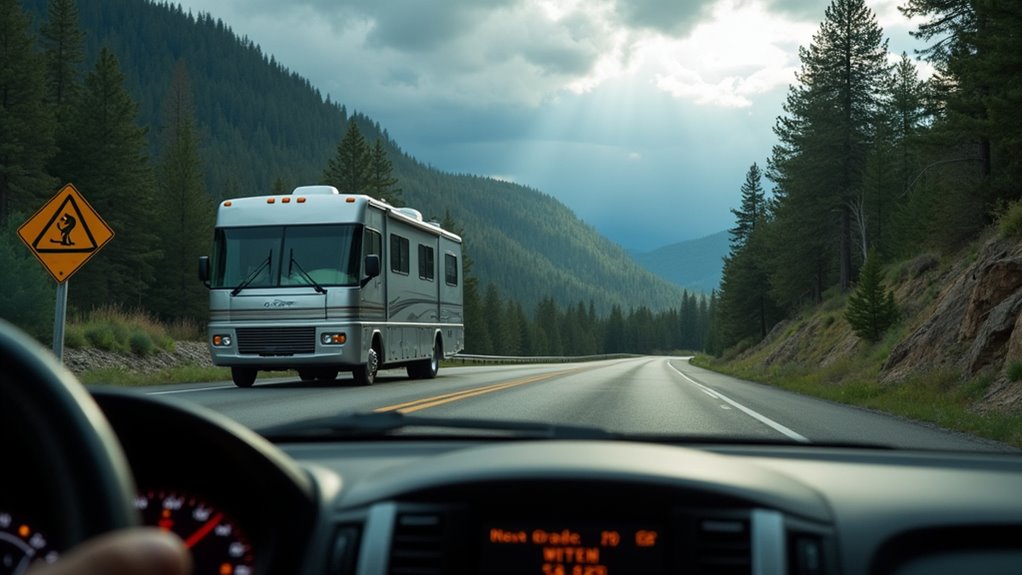
Whether you’re planning a cross-country adventure or a weekend getaway, your RV’s actual driving range depends heavily on the conditions you encounter along the way.
Weather plays a significant role, as cold temperatures, strong winds, and rain can reduce your fuel efficiency. You’ll also burn more fuel climbing steep hills or driving on rough, unpaved roads.
Your driving habits make a big difference too. Maintaining speeds between 55-60 mph maximizes efficiency, while aggressive acceleration and frequent stops drain your tank faster. Diesel engines tend to provide better fuel economy than gasoline models.
Watch your cargo weight and avoid roof-mounted equipment that creates drag. To get the most miles from each tank, keep your tires properly inflated, change air filters regularly, and stay current with engine maintenance.
Smart route planning that avoids congestion and minimizes elevation changes will help extend your range.
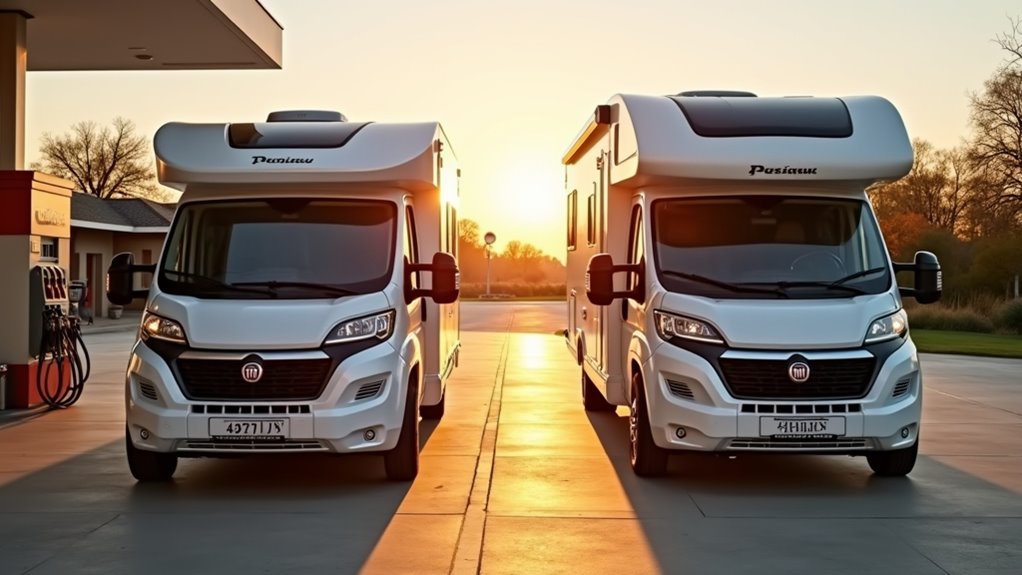
When comparing RVs across continents, you’ll notice striking differences in fuel efficiency between European and American models.
European motorhomes typically achieve 25-35 MPG, while American RVs average just 6-10 MPG.
You’ll find European RVs are designed with efficiency in mind, featuring diesel engines and compact builds that suit narrow roads. Their smaller size and lighter weight contribute markedly to better fuel economy. Maintaining speeds of 55 to 60 mph provides optimal fuel efficiency for both types of motorhomes.
In contrast, American RVs often use less efficient petrol engines and larger builds.
The difference is particularly evident when looking at various classes.
European Class A motorhomes average around 25 MPG, while their smaller Class B and C counterparts can reach up to 46 MPG.
If you’re prioritizing fuel efficiency, you’ll find European designs offer considerable savings in operational costs.

Understanding real-world RV range requires more than simple math calculations. While you can multiply tank size by average MPG, actual driving distances often differ from theoretical ranges.
For Class A RVs, you’ll typically get 500-600 miles from a 100-gallon tank, though daily driving usually falls between 180-325 miles.
Class B vans achieve 250-400 miles per tank, depending on whether you’re using gas or diesel fuel.
Class C motorhomes commonly reach 350-550 miles on a full tank. Cruise America’s rental RVs average 6-10 MPG on the road, making them a fuel-efficient choice for travelers.
Your actual range will vary based on key factors: terrain (mountains reduce range), driving conditions (stop-and-go traffic burns more fuel), vehicle load (cargo and passengers decrease efficiency), and weather (extreme temperatures affect performance).
For practical planning, it’s best to schedule fuel stops well before reaching your theoretical maximum range.
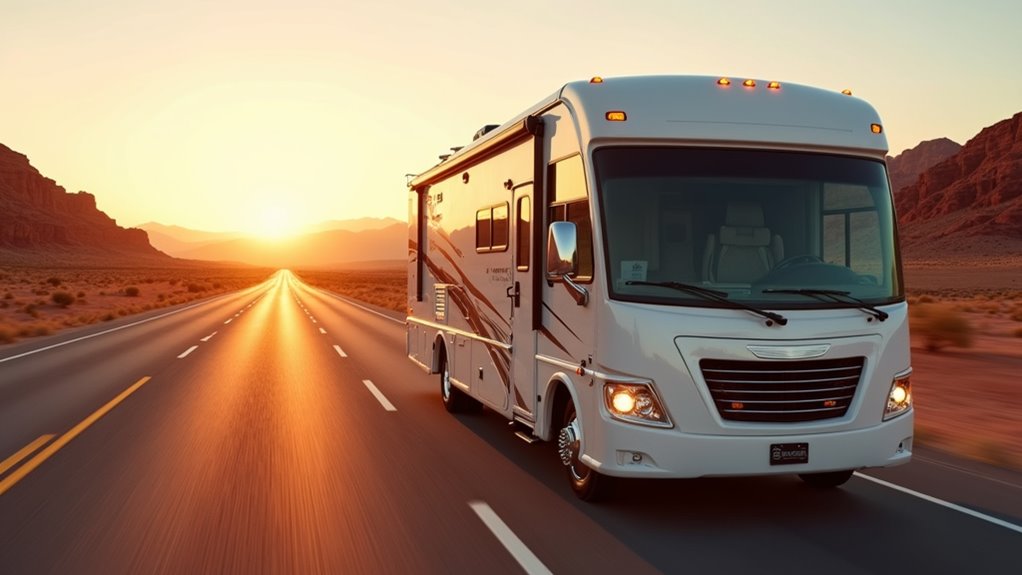
To maximize your RV’s range beyond baseline calculations, several proven strategies can extend your travel distance between fuel stops.
You’ll find that combining equipment modifications with smart driving practices creates the most notable impact on fuel efficiency.
When parked at campsites, shore power connections can preserve battery life by providing direct electrical power to your RV systems.
Modern electric RV solutions like installing a Tesla battery pack can provide supplementary power for extended range capabilities.
These practical approaches, when implemented together, can considerably improve your RV’s range and reduce the frequency of fuel stops during your travels.

Weather and terrain conditions play crucial roles in determining your RV’s actual driving range.
Cold temperatures around -5°C can reduce your fuel economy by up to 15% compared to driving in 25°C weather, as your engine needs more time to warm up and oil thickens.
You’ll also face decreased efficiency when driving through snow, ice, or rain due to slower speeds and increased braking.
Using cruise control helps maintain steady speeds and optimal fuel efficiency in favorable conditions.
Terrain greatly impacts your range too.
Steep inclines force your engine to work harder, while mountainous roads require constant acceleration and deceleration.
Wind direction matters – headwinds can decrease your MPG by 24%, while crosswinds make steering corrections necessary.
You’ll get the best range on flat highways at steady speeds below 55 mph, where you can maintain consistent fuel consumption without fighting against challenging conditions.
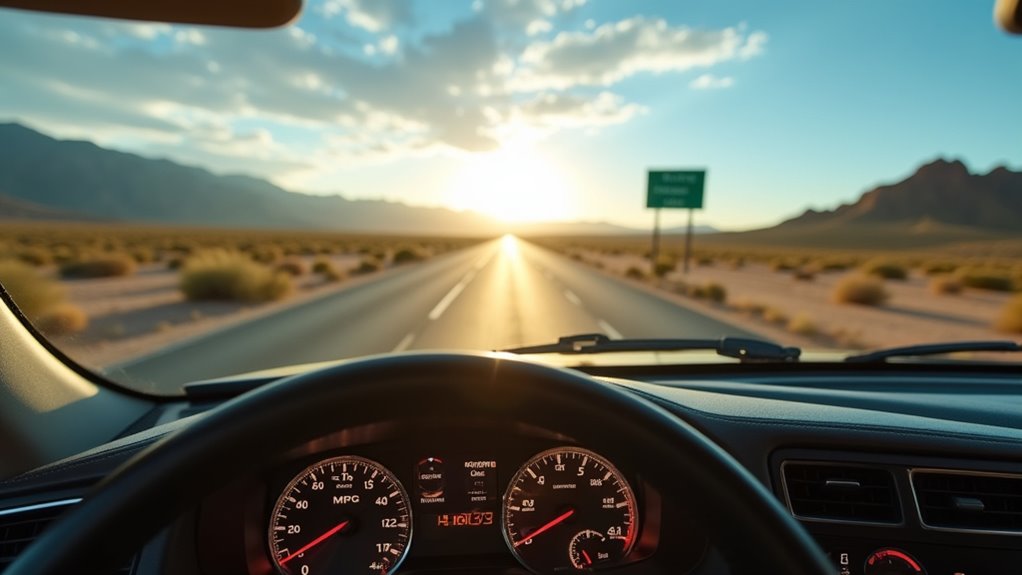
While terrain and weather affect your RV’s range, you can take specific steps to maximize fuel efficiency regardless of conditions.
Don’t let external factors limit your RV’s efficiency. Smart driving techniques can help maximize fuel economy in any situation.
By implementing smart driving habits and maintaining your vehicle properly, you’ll get more miles from each tank of fuel. Gas Buddy apps can help locate the cheapest fuel prices along your route to reduce overall costs.
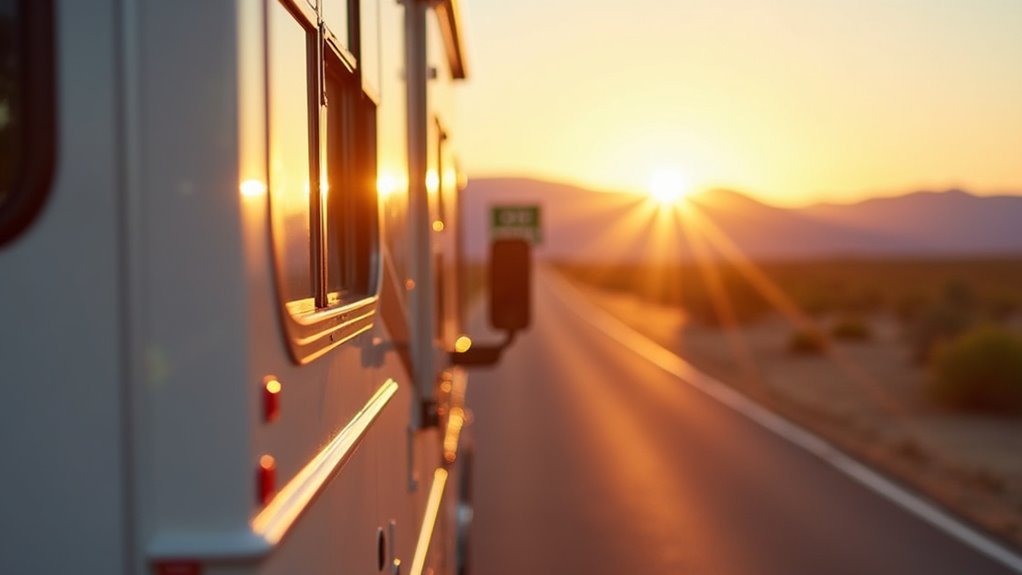
Successful long-distance RV trips depend heavily on understanding your vehicle’s range and planning fuel stops strategically.
When mapping your route, you’ll want to identify fuel stations every 200-400 miles, depending on your RV’s tank size and efficiency. The Roadtrip app provides smart route planning to help you find the most fuel-efficient paths.
Remember that real-world conditions will affect your actual range. Hills, headwinds, and high speeds can reduce your fuel economy by 10-20%. Many travelers use RV rental platforms to test different models before committing to a purchase.
It’s smart to build in a buffer by planning stops before you’re running on empty. For remote routes, you might need to carry spare fuel.
Use fuel cost calculators to budget accurately by inputting your RV’s tank size, MPG, and total distance.
Consider seasonal weather patterns and elevation changes along your route, as these factors will impact your vehicle’s performance and fuel consumption.
Just when you think you’ve got your RV’s range figured out, remember that it’s not as simple as the numbers suggest. You’ll need to take into account your specific model, driving habits, and route conditions. While Class As might get 300-500 miles per tank and Class Bs can reach up to 528 miles, your actual mileage will vary. Plan your trips with a 75% range buffer to avoid any fuel-related surprises on the road.